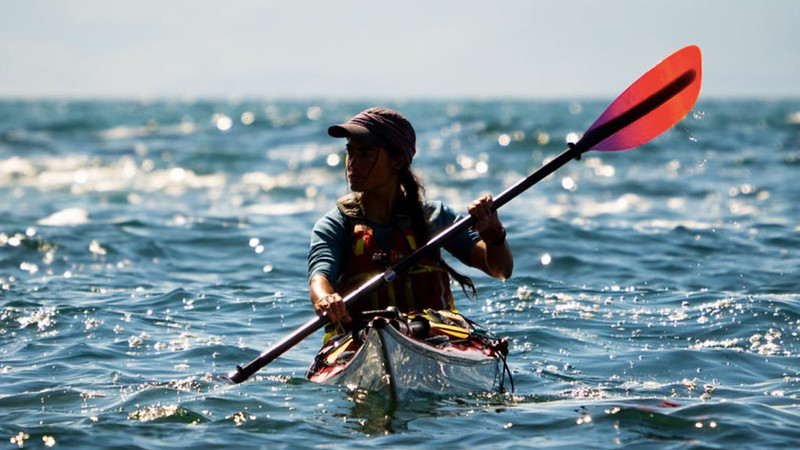Photo by Arisaig Sea Kayak Centre
It is easy to help determine the correct paddle size for someone when you are on the water with them and you have a suitable range of paddle lengths and blade sizes. You simply give them a range to try, find out what they prefer and then refine the choice until you get to their preferred dimensions.
Doing it here though is so much harder. You (the paddler) have to really understand all the factors that determine the choice and yet at the same time we (the paddlesports industry) have to simplify that choice or we would all be buried under lists of numbers. And even then we won’t necessarily be right as there will always be outliers, and knowing you, you are probably one of them.
And so yes I am going to say that you have to try paddles before you really know what will suit you, but at the same time we have to make some recommendations. And at the end of this article we have done that, but before you go scrolling through to the end, lets have a look at understanding some of these dimension determining factors.
Body Dimensions
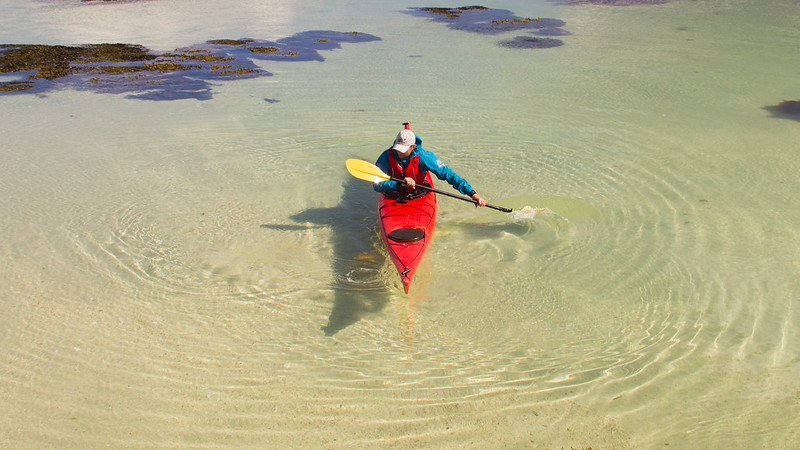 Photo by Arisaig Sea Kayak Centre
Photo by Arisaig Sea Kayak Centre
Firstly we are looking at you, or rather your body dimensions. The two primary ones being your torso height and your arm span. However, here we have to simplify those to your height. Now arm span has a significant positive correlation to height, (a Pearson's r value of 0.99), but torso length, less so, and actually, it is your shoulder height above the water line that we really want and that has more variables involved and so I hope you can understand why we simplify this to height.
A taller paddler will want a longer paddler to suit their bigger body dimensions and their longer levers will be able to pull a bigger blade. Also their cadence will slightly slower.
Boat Dimensions
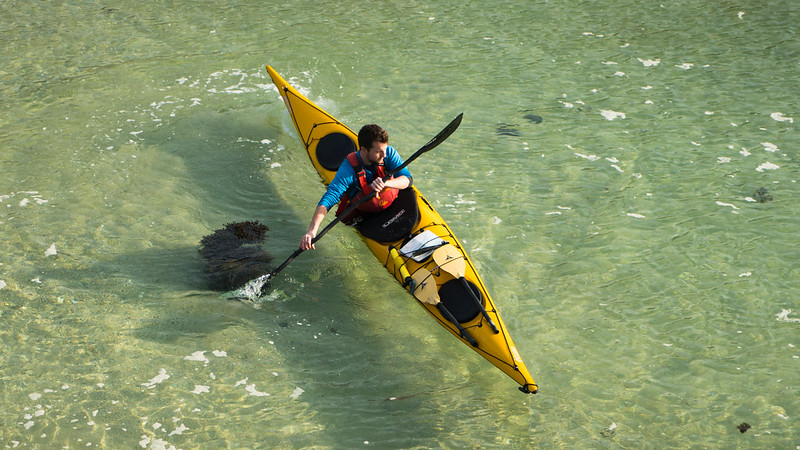 Photo by Arisaig Sea Kayak Centre
Photo by Arisaig Sea Kayak Centre
Here we are talking sea kayaks, not necessarily touring kayaks (whatever the difference is) and definitely not sit on tops. These all tend to be wider than sea kayaks and therefore need longer paddles, as yes, boat width is a determining factor of paddle length. So here we are looking at boat widths of about 20 to 22 inches.
Boat length is also a determining factor of paddle length, or rather boat waterline length, as the waterline length has a strong determining factor on the speed of the boat. If we simplify it to; a longer boat is faster and therefore require's a longer paddle to paddle at the cadence that you are comfortable with, and vice versa with a shorter boat. Here we are looking at sea kayak lengths of around 16 to 17 foot.
Paddling Angle
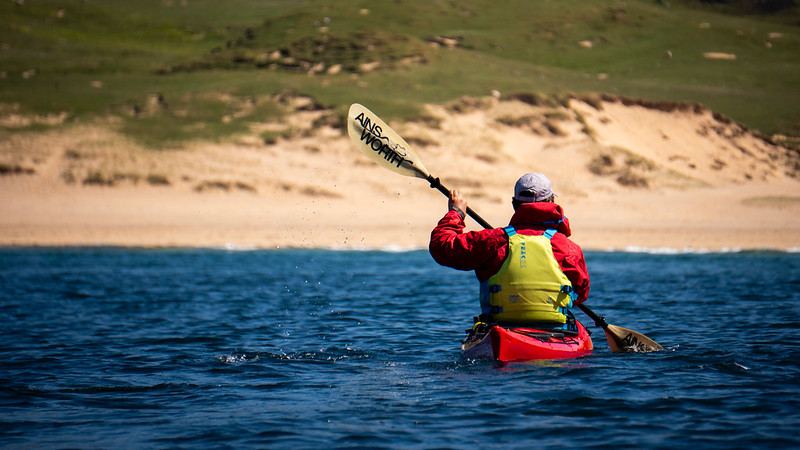 Photo by Arisaig Sea Kayak Centre
Photo by Arisaig Sea Kayak Centre
Another determining factor is the angle that you want to use the paddle at, i.e. high angle and low angle paddling styles.
A high angle paddling style, with its nearer to vertical paddle shaft, produces a shorter stroke that requires more power for a shorter amount of time per stroke. Therefore you need a bigger blade on a shorter paddle. And the tolerances for getting these right are fairly small with a high angle style.
A low angle paddling style, with its more horizontal paddle shaft, produces a longer stroke that requires less power but for a longer time. Therefore you need a smaller blade on a longer paddle. However the tolerances for getting these right are fairly large.
Now in reality these two paddling styles are a spectrum. Some paddlers will have a higher angle than the recommendations are based on and as such may need a shorter paddle, and many paddlers may find themselves somewhere in between high angle and low angle. For these paddlers they can extrapolate from the charts, somewhere in between the two values.
On a similar note if you give someone a paddle that is too long and/or the blade is too big for them to use with a high angle stroke they will normally use a lower angle stroke to compensate.
It should also be noted that although many blades are designed to be used with either low angle or high angle strokes, they can all be used for either. For some designs this can involve some compromise however for many there is very little.
Experience
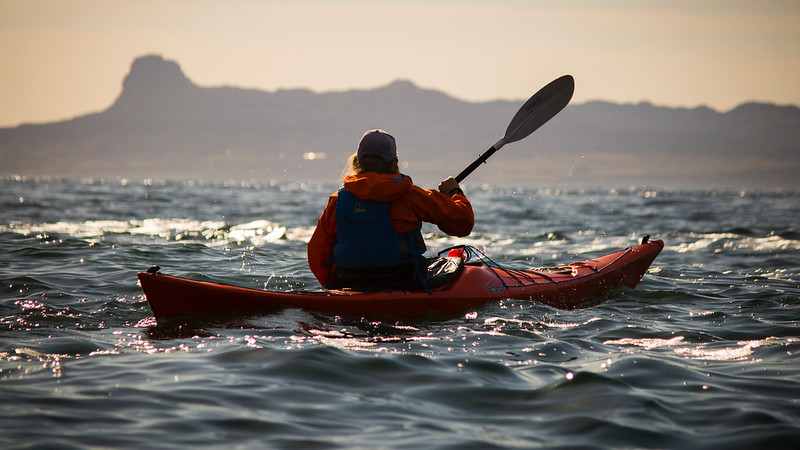 Photo by Arisaig Sea Kayak Centre
Photo by Arisaig Sea Kayak Centre
The experience of the paddler is another determining factor of both paddle length and blade size.
A more experienced paddler is more efficient with their paddle and can get more out of a shorter paddle and smaller blade. However they are also likely to be more paddle fit and so can also handle a longer paddle and bigger blade. Also they may consider sea kayaking to be doing ultra long distance expeditions and so want a long paddle with a small blade; or extreme rock hopping where they want a short paddle with a big blade. This makes it very hard to recommend a paddle size for them. Fortunately they are also more likely to know what paddle they want, particularly in reference to the type of paddling they like to do, and so these recommendations are not for them.
A less experienced paddler will feel the benefit of a bigger blade and longer paddle. This is particularly noticeable in strokes where brute force can be deployed effectively such as turning, bracing and rolling. However before you go rushing out to buy the biggest, longest paddle you can to help with your rolling, I should point out that a paddle that is big and long enough to make rolling as easy as possible would be far too big to paddle efficiently with.
With these recommendations we are looking at intermediate level sea kayakers.
Sea Kayak Paddle Size Recommendations
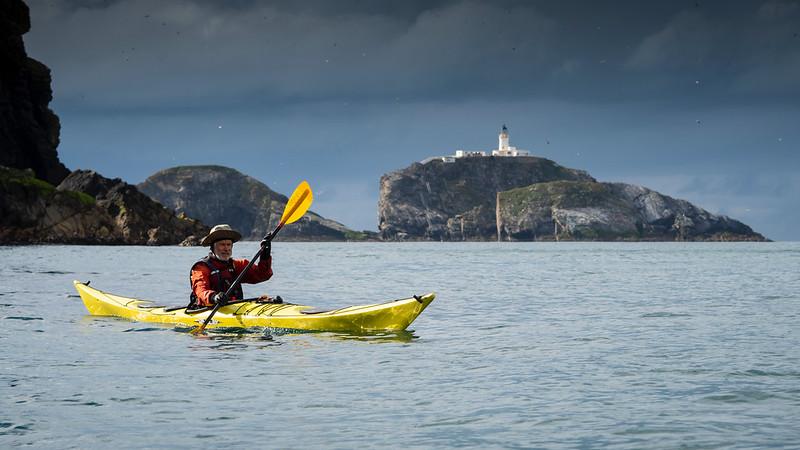 Photo by Arisaig Sea Kayak Centre
Photo by Arisaig Sea Kayak Centre
So with all that said, and so much more that could be said, here is our best attempt at sea kayak paddle size recommendations:
|
Boat length approx 16ft-17ft; Boat width approx 20-22in; Intermediate skill level, Euro paddle. |
|||
|
Higher Angle Paddling Style |
|||
|
Size |
Height of Paddler |
Paddle Length |
Blade Size |
|
XXL |
190cm (6ft 3in) |
212-214cm |
700-750cm2 |
|
XL |
185cm (6ft 1in) |
210-212cm |
675-725cm2 |
|
L |
180cm (5ft 11in) |
208-210cm |
650-700cm2 |
|
M |
175cm (5ft 9in) |
206-208cm |
625-675cm2 |
|
S |
170cm (5ft 7in) |
204-206cm |
600-650cm2 |
|
XS |
165cm (5ft 5in) |
202-204cm |
575-625cm2 |
|
XXS |
160cm (5ft 3in) |
200-202cm |
550-600cm2 |
|
|
|
|
|
|
Lower Angle Paddling Style |
|||
|
Size |
Height of paddler |
Paddle Length |
Blade Size |
|
XXL |
190cm (6ft 3in) |
225-230cm |
625-725cm2 |
|
XL |
185cm (6ft 1in) |
221-226cm |
600-700cm2 |
|
L |
180cm (5ft 11in) |
217-222cm |
575-675cm2 |
|
M |
175cm (5ft 9in) |
213-218cm |
550-650cm2 |
|
S |
170cm (5ft 7in) |
209-214cm |
525-625cm2 |
|
XS |
165cm (5ft 5in) |
205-210cm |
500-600cm2 |
|
XXS |
160cm (5ft 3in) |
201-206cm |
475-575cm2 |
Final thoughts
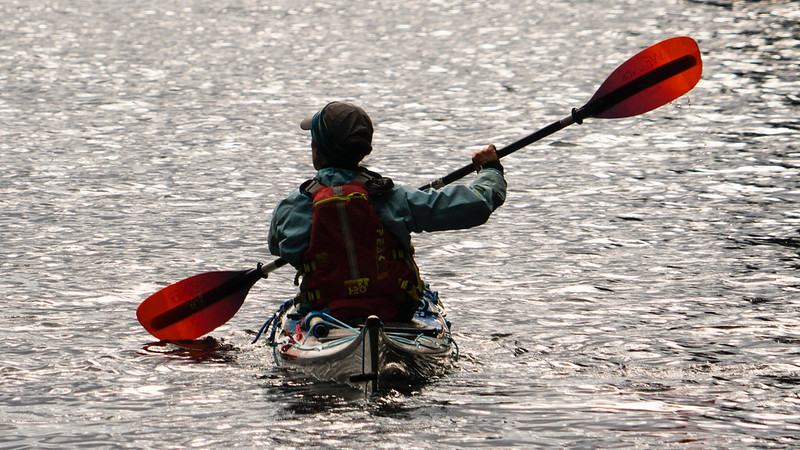 Photo by Arisaig Sea Kayak Centre
Photo by Arisaig Sea Kayak Centre
Here we are looking at sea kayak lengths of around 16 to 17 foot in length. If you are paddling a 17 to 18 foot boat you could probably add 2 cms the high angle paddle lengths.
We also need to understand that one aspect of our paddle dimensions will also affect the choice of another. So if we choose to have a slightly bigger blade then we may need to choose to have a correspondingly shorter shaft.
An added complication is manufactures measure paddle length differently. E.g. Werner measure tip to tip, Celtic measure down the centreline, giving about a 2cm difference.
As we said at the start you do really need to try a paddle before you buy it, and I appreciate that can be difficult. However if every time you go paddling, you try the paddle of everyone who you are paddling with, hopefully you will eventually find a paddle that suits you.

By Philip Clegg
With over two decades of working in the sea kayaking industry, Phil can be found on a daily basis coaching for Sea Kayaking Anglesey. That's when he's not expeditioning, playing or putting kit to the test.



